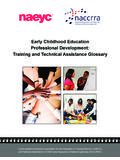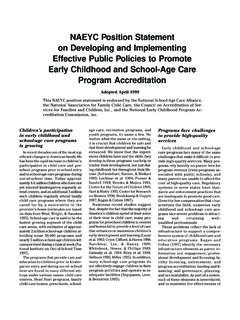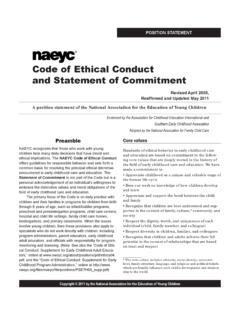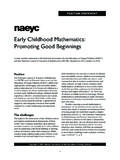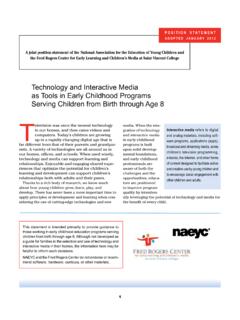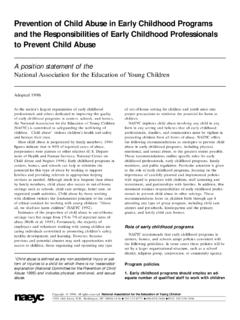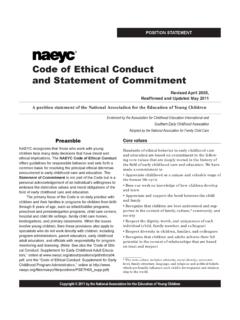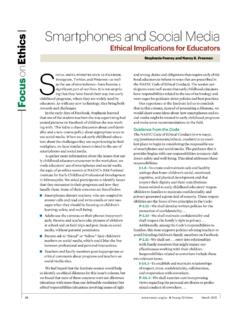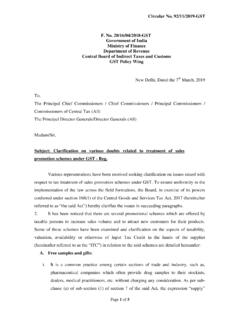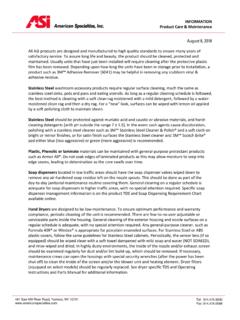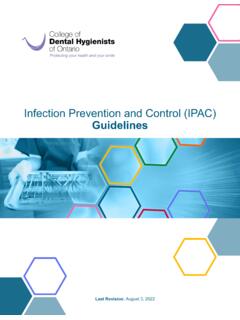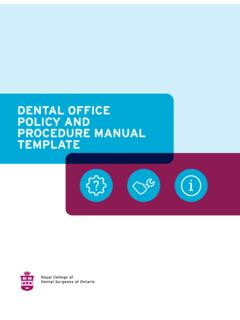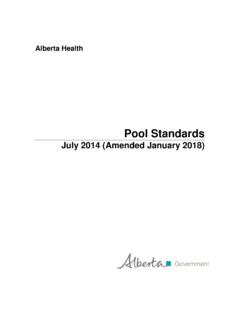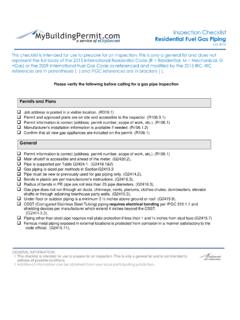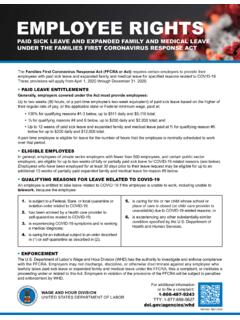Transcription of Cleaning, Sanitizing, and Disinfection Frequency Table - …
1 cleaning , sanitizing , and Disinfection Frequency Table1 cleaning , sanitizing , and Disinfection Frequency TableDefinitions1 Cleaning2 Physically removing all dirt and contamination, oftentimes using soap and water. The friction of cleaning removes most germs and exposes any remaining germs to the effects of a sanitizer or disinfectant used later. Sanitizing3 Reducing germs on inanimate surfaces to levels considered safe by public health codes or regulations. sanitizing may be appropriate for food service tables, high chairs, toys, and pacifiers. Disinfecting Destroying or inactivating most germs on any inanimate object, but not bacterial spores. Disinfecting may be appropriate for diaper tables, door and cabinet handles, toilets, and other bathroom surfaces. Detergent A cleaning agent that helps dissolve and remove dirt and grease from fabrics and surfaces.
2 Soap can be considered a type of detergent. Dwell Time The duration a surface must remain wet with a sanitizer/disinfectant to work effectively. Germs Microscopic living things (such as bacteria, viruses, parasites and fungi) that cause , sanitizing , and Disinfection Frequency Table2 cleaning , sanitizing , and Disinfecting Frequency Table1 Relevant to NAEYC Standard 5 (Health), especially Topic C: Maintaining a Healthful EnvironmentAreasBefore each UseAfter each UseDaily (End of the Day)WeeklyMonthlyComments4 Food AreasFood preparation surfacesClean, and then SanitizeClean, and then SanitizeUse a sanitizer safe for food contactEating utensils & dishesClean, and then SanitizeIf washing the dishes and utensils by hand, use a sanitizer safe for food contact as the final step in the process; use of an automated dishwasher will sanitize Tables & highchair trays Clean, and then SanitizeClean, and then SanitizeCountertopsCleanClean, and then SanitizeUse a sanitizer safe for food contactFood preparation appliancesCleanClean, and then SanitizeMixed use tablesClean, and then SanitizeBefore serving foodRefrigeratorCleanToilet & Diapering AreasChanging tablesClean, and then DisinfectClean with detergent, rinse, disinfectPotty chairsClean, and then DisinfectUse of potty chairs is not recommended, but if used should be cleaned and disinfected after each washing sinks & faucetsClean, and then DisinfectCountertopsClean, and then DisinfectToiletsClean, and then DisinfectCleaning, sanitizing , and Disinfection Frequency Table3 AreasBefore each UseAfter each UseDaily (End of the Day)
3 WeeklyMonthlyComments4 Diaper pailsClean, and then DisinfectFloorsClean, and then DisinfectDamp mop with a floor cleaner/disinfectantChild Care AreasPlastic mouthed toysCleanClean, and then SanitizePacifiersCleanClean, and then SanitizeReserve for use by only one child; use dishwasher or boil for one minute HatsCleanClean after each use if head lice present Door & cabinet handlesClean, and then DisinfectFloorsCleanSweep or vacuum, then damp mop, (consider micro fiber damp mop to pick up most particles) Carpets5 and Large Area RugsCleanCleanDaily: Vacuum6 when children are not present; clean with a carpet cleaning method consistent with local health regulations and only when children will not be present until the carpet is dryMonthly: Wash carpets at least monthly in infant areas and at least every three months in other areas, or when soiledSmall RugsCleanCleanDaily: Shake outdoors or vacuumWeekly: LaunderMachine washable cloth toysCleanLaunderDress-up clothesCleanLaunderPlay activity centersCleanCopyright 2018.
4 National Association for the Education of Young Children. All other rights reserved. Revised July 2018 AreasBefore each UseAfter each UseDaily (End of the Day)WeeklyMonthlyComments4 Drinking FountainsClean, and then DisinfectComputer keyboards7 Clean, and then SanitizeUse sanitizing wipes, do not use sprayPhone receiversCleanSleeping AreasBed sheets & pillow casesCleanClean before use by another childCribs, cots, & matsCleanClean before use by another childBlanketsClean1 Definitions and Table adapted from: American Academy of Pediatrics, American Public Health Association, National Resource Center for Health and Safety in Child Care and Early Education. Caring for Our Children: National Health and Safety Performance Standards; Guidelines for Early Care and Education Programs. Routine cleaning with detergent (see definition above) and water is the most useful method for removing germs from surfaces in the child care setting.
5 Safer cleaning products are not only less-toxic and environmentally safer, but they also often cost the same or less than conventional cleaners. Green Seal and UL/EcoLogo are non-profit companies that research and certify products that are biodegradable and environmentally sanitizing and disinfecting can be achieved with a solution of chlorine bleach and water. However, the use of chlorine bleach for disinfecting and sanitizing is not a requirement; there are other EPA-approved sanitizing and disinfecting agents that can be used instead of chlorine bleach/water solutions. When purchasing products, look for an EPA registration number on the product label, which will describe the product as a cleaner, sanitizer, or disinfectant. When using sanitizing and disinfecting agents, it is important that manufacture instructions for dwell time (see definition above) is adhered sanitizing or disinfecting is warranted, staff use EPA-registered least-toxic disinfecting and sanitizing products.
6 The easiest way to find least-toxic cleaning products is to use products that have been tested and certified by a third party group such as Green Seal, UL/EcoLogo, and/or EPA Safer Choice. For alternative methods and products to be used in lieu of chlorine bleach, please refer to the Green cleaning Toolkit for Early Care and Education, a set of resources developed by the EPA. Follow manufacturer instructions for how to mix chlorine bleach / water solutions for sanitizing and disinfecting. Refer to Caring for Our Children, Appendix J, ( ) for instructions on how to identify EPA-registered sanitizing and disinfecting products (including chlorine bleach), and how to safely prepare chlorine bleach solutions. 4 In addition to the frequencies listed here, all items should be cleaned when visibly It is best practice to use alternatives to installed carpets in the child care All area rugs and carpeted areas should be vacuumed with a HEPA filtered vacuum and according to instructions for the vacuum.
7 Use proper vacuuming technique: (1) push the vacuum slowly; (2) do a double pass vacuum in 2 directions, perpendicular to each other; (3) start at the far end of a room and work your way out (to avoid immediate re-contamination); (4) empty or replace vacuum bags when to 2/3 Each Use of computer keyboards should be defined as use by each group of children, not each individual child. Keyboards connected to computers should be cleaned daily if one group is in the room all day, or after each different group of children uses the room. These guidelines do not apply to keyboards that are unplugged and used for dramatic play.
